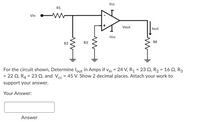
Introductory Circuit Analysis (13th Edition)
13th Edition
ISBN: 9780133923605
Author: Robert L. Boylestad
Publisher: PEARSON
expand_more
expand_more
format_list_bulleted
Concept explainers
Question

Transcribed Image Text:Vc
R1
Vin
Vout
lout
-Vcc
R2
R3
R4
For the circuit shown, Determine lout in Amps if vin = 24 V, R1 = 23 Q, R2 = 16 Q, R3
= 22 Q, R4 = 23 Q, and Vec = 45 V. Show 2 decimal places. Attach your work to
support your answer.
Your Answer:
Answer
Expert Solution
This question has been solved!
Explore an expertly crafted, step-by-step solution for a thorough understanding of key concepts.
Step by stepSolved in 2 steps with 2 images

Knowledge Booster
Learn more about
Need a deep-dive on the concept behind this application? Look no further. Learn more about this topic, electrical-engineering and related others by exploring similar questions and additional content below.Similar questions
- The circuit below, you may note, does not match any of the common op-amp circuits. By performing circuit analysis, determine the voltage across the load resistor R5. You may assume that V1 = 3.6 V, V2 = 4.7 V, R1 = 37 kQ, R2 = 62 KQ, R3 = 77 kQ, R4 = 71 kQ, and R5 = 90 kQ. R1 ww V1 + R2 V2 R3 R4 R5 mm Darrow_forwardGiven the circuit below, the current through the feedback resistor is mA. Round-off to 2 decimal places and write your answer in the box. (Example: if your answer is 1.25mA, simply write 1.25) R₁ V1o W V2 R₂ www Rf www VOUT R₁ R₂=R₁=28kn, V1-2.6V, V2=2.3Varrow_forwardFirst,Calculate the input resistance Rin defined as Vin/Iin . Hint: Assuming you know the variable Vin, find Iin in terms of Vin. Substitute Iin into Vin/Iin, then variables Vin will cancel each other on the numerator and denominator. You will get a number that represents Rin. Second,Construct the resistive network in figure 5 with Vin = 5V from the Arduino POWER section. Measure Vin. Then, measure Iin by inserting the DMM between node n1 and n2. Divide these two values to get Rin. Report Vin, Iin, and Rin. Then, Are the measured input resistance values the same when you use Vin = 3.3V and when you use Vin = 5V? Is Rin independent from Vin and Iin? Explain it. Also, include a photo of your circuit!arrow_forward
arrow_back_ios
arrow_forward_ios
Recommended textbooks for you
 Introductory Circuit Analysis (13th Edition)Electrical EngineeringISBN:9780133923605Author:Robert L. BoylestadPublisher:PEARSON
Introductory Circuit Analysis (13th Edition)Electrical EngineeringISBN:9780133923605Author:Robert L. BoylestadPublisher:PEARSON Delmar's Standard Textbook Of ElectricityElectrical EngineeringISBN:9781337900348Author:Stephen L. HermanPublisher:Cengage Learning
Delmar's Standard Textbook Of ElectricityElectrical EngineeringISBN:9781337900348Author:Stephen L. HermanPublisher:Cengage Learning Programmable Logic ControllersElectrical EngineeringISBN:9780073373843Author:Frank D. PetruzellaPublisher:McGraw-Hill Education
Programmable Logic ControllersElectrical EngineeringISBN:9780073373843Author:Frank D. PetruzellaPublisher:McGraw-Hill Education Fundamentals of Electric CircuitsElectrical EngineeringISBN:9780078028229Author:Charles K Alexander, Matthew SadikuPublisher:McGraw-Hill Education
Fundamentals of Electric CircuitsElectrical EngineeringISBN:9780078028229Author:Charles K Alexander, Matthew SadikuPublisher:McGraw-Hill Education Electric Circuits. (11th Edition)Electrical EngineeringISBN:9780134746968Author:James W. Nilsson, Susan RiedelPublisher:PEARSON
Electric Circuits. (11th Edition)Electrical EngineeringISBN:9780134746968Author:James W. Nilsson, Susan RiedelPublisher:PEARSON Engineering ElectromagneticsElectrical EngineeringISBN:9780078028151Author:Hayt, William H. (william Hart), Jr, BUCK, John A.Publisher:Mcgraw-hill Education,
Engineering ElectromagneticsElectrical EngineeringISBN:9780078028151Author:Hayt, William H. (william Hart), Jr, BUCK, John A.Publisher:Mcgraw-hill Education,

Introductory Circuit Analysis (13th Edition)
Electrical Engineering
ISBN:9780133923605
Author:Robert L. Boylestad
Publisher:PEARSON

Delmar's Standard Textbook Of Electricity
Electrical Engineering
ISBN:9781337900348
Author:Stephen L. Herman
Publisher:Cengage Learning

Programmable Logic Controllers
Electrical Engineering
ISBN:9780073373843
Author:Frank D. Petruzella
Publisher:McGraw-Hill Education

Fundamentals of Electric Circuits
Electrical Engineering
ISBN:9780078028229
Author:Charles K Alexander, Matthew Sadiku
Publisher:McGraw-Hill Education

Electric Circuits. (11th Edition)
Electrical Engineering
ISBN:9780134746968
Author:James W. Nilsson, Susan Riedel
Publisher:PEARSON

Engineering Electromagnetics
Electrical Engineering
ISBN:9780078028151
Author:Hayt, William H. (william Hart), Jr, BUCK, John A.
Publisher:Mcgraw-hill Education,